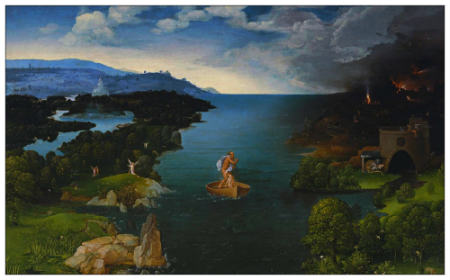Search:: Artists Alphabetically Artists by Country Artists by Century Artists by Movement
Antwerp SchoolMany of the most important Northern Renaissance painters worked in Antwerp in the 15th Century. Author James Edward Parrott descibes the city, "Antwerp, with its deep and convenient river, stretched its arm to the ocean, and caught the golden prize as it fell from its sister cities' grasp. No city except Paris surpassed it in population; none approached it in commercial splendour."
James Edward Parrott further states "The city began to decline during the reign of Philip II., who was King of Spain and master of the Netherlands. In 1576 Spanish soldiers whose pay was in arrears broke into mutiny, and stormed and sacked several of the richest towns of Flanders, including Antwerp. Early in November of that year they entered the city, burnt more than a thousand houses, slew more than eight thousand citizens, plundered right and left, and behaved with the utmost cruelty. Such was the "Spanish Fury," which still forms a landmark in Flemish history. With the help of William of Orange, the Spaniards were driven out of Antwerp."
Important Painters of the Antwerp School
Pieter Bruegel the Elder
Joos van Cleve
Quentin Matsys
Colijn de Coter
Joachim Patinir
Pieter Brueghel the Younger
Anthony van Dyck
Peter Paul Rubens

Landscape with Charon Crossing the Styx by Joachim Patinir c.1519, Prado Museum, Madrid to view a larger version of ths painting click here
Key Words, People and Principal Phrases, Characteristics Related to the Northern Renaissance Art Movement - allegorical painting, rebirth, invention of oil painting, Hieronymus Bosch, Limbourg Brothers, Desiderius Erasmus, Robert Campin, Jan Van Eyck, Jean Fouquet, Albrecht Dürer, Johannes Gutenberg, Johann Reuchlin, Martin Luther, rise of the merchant class, world landscape, Low Countries, Protestant Reformation, Calvinisim, glazing, impasto, scriptorium, illuminator, invention of the printing press, woodcuts, engravings, Antwerp School, Guild of Saint Luke, commerce, Flemish School, Northern Europe, Flanders, Bruges, renewed interest in classical learning, mythological scenes, genre painting, landscapes, portraits, moralizing overtones, human vices, lust, paradise, spirituality, piousness, living a simple life, reform, Human Reasoning, tradesmen at work, idyllic scenes of peasants, playing games, feasting, linear perspective, \Heliocentric Theory, humour, satire, spiritually significant, illuminated manuscript, idealized biblical themes, scriptorium, emotion, illuminator, iconoclast, Age of Discovery, Virgin and Child, axonometric drawing, curiosity about the natural world, realistic use of colours and light, Old Testament stories, Gospel parables, The Blackdeath, Christian symbolism
If you feel you have worthwhile information you would like to contribute we would love to hear from you. We collect essential biographical information and artist quotes from folks all over the globe and appreciate your participation. When submitting please, if possible, site the source and provide English translation. Email to millardmulch@gmail.com
☼☼☼☼☼
© HistoryofPainters.com If you like this page and wish to share it, you are welcome to link to it, with our thanks. updated 3/7/2017